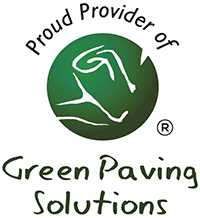What you need to know before taking the LEED

Updated on 12/16/24
In recent years, the movement toward sustainability and environmentally conscious construction has gained significant momentum. As we explored in our previous post, LEED® certification offers a clear framework for verifying that a building project meets the highest green building and performance measures. But it’s not just about putting a plaque on your wall—achieving LEED® certification can improve energy efficiency, reduce resource consumption, and create healthier environments for occupants, all while enhancing the property’s marketability and long-term value.
When it comes to paving and exterior site work, there are many opportunities to make choices that align with the criteria set forth by the U.S. Green Building Council’s (USGBC) LEED® Rating Systems™. Whether you are new to the concept or looking to elevate your current sustainability efforts, it’s helpful to understand which metrics can tip the scales in favor of LEED® certification and how a trusted paving partner like Rose Paving can help guide you there.
Breaking Down the LEED® Rating Systems™
Before diving into the specifics of how paving materials and methods can earn points, it’s useful to consider where your project fits within the broader spectrum of LEED® Rating Systems™. There are dedicated rating systems tailored to various project types, such as:
- LEED® for Building Design and Construction (BD+C): Ideal for new buildings or major renovations, this includes provisions for both residential and commercial projects.
- LEED® for Interior Design and Construction (ID+C): Focuses on interior fit-outs and tenant improvements.
- LEED® for Building Operations and Maintenance (O+M): Suited for buildings undergoing improvements to their ongoing operations.
- LEED® for Neighborhood Development (ND): Addresses larger-scale community projects, emphasizing location, design, and infrastructure.
Depending on the nature and scope of your project, you’ll want to choose the rating system that best reflects your goals, whether it’s a single building remodel or a new, multi-building complex.
Connecting Paving Solutions to LEED® Points
The categories within LEED®—such as Sustainable Sites, Materials & Resources, Water Efficiency, Energy & Atmosphere, and Indoor Environmental Quality—each offer their own potential opportunities for earning points. For exterior work like paving, we focus primarily on areas where hardscapes, stormwater management, and material selection intersect with these categories.
- Sustainable Sites:
Achieving LEED® certification often begins with thoughtful site selection and responsible development practices. Paving solutions can play a vital role here:- Reflective Pavement Coatings: By using solar-reflective coatings on parking lots and sidewalks, you help mitigate the urban heat island effect. High Solar Reflectance Index (SRI) materials reflect more of the sun’s rays rather than absorbing them, keeping surfaces cooler.
- Permeable Pavements: Utilizing permeable paver bricks, pervious concrete, or porous asphalt helps manage stormwater onsite, reducing runoff, improving local water quality, and contributing to more sustainable site development.
- Water Efficiency:
When you incorporate permeable paving materials, you create a system that encourages natural infiltration of rainwater, filtering out pollutants before they reach local waterways. This approach can help reduce the burden on municipal stormwater systems and align with LEED® credits tied to effective stormwater management. Bioswales and other green infrastructure are also beneficial, allowing for natural filtration and potentially earning additional points under the Water Efficiency category. - Energy & Atmosphere:
While paving solutions may not directly impact a building’s HVAC or electrical systems, they can indirectly contribute to a more efficient site design. Cool pavements, for instance, lower surrounding air temperatures and can potentially reduce the cooling demand of nearby buildings. This complementary effect can support broader energy strategies aimed at meeting LEED® criteria. - Materials & Resources:
Materials selection is another critical area where your choice of paving products can add up to meaningful LEED® points. Incorporating recycled content, such as slag or fly-ash concrete and recycled rubber parking bumpers, reduces the use of virgin materials and supports a more circular economy. Reusing existing asphalt or concrete through reclamation processes also cuts down on waste and supports responsible material sourcing. By thoughtfully selecting products with documented environmental attributes—like certified recycled content—you can earn points in this category. - Indoor Environmental Quality:
Although paving materials are typically installed outdoors, the choices you make on the exterior can influence the overall environment inside the building. Cooler, lighter-colored pavements can help reduce heat entering the building. Better stormwater management can improve local humidity levels and air quality. While these effects may be indirect, they can still support a healthier indoor environment as part of your broader sustainability goals.
Key Metrics That Matter
To achieve LEED® certification, your project must meet certain prerequisites and accumulate points across the categories mentioned above. Some key metrics to pay attention to when working with paving solutions include:
- Solar Reflectance Index (SRI): Ensuring that your pavement meets or exceeds SRI requirements will help earn points related to reducing the heat island effect.
- Permeability and Infiltration Rates: For permeable pavements and green infrastructure, infiltration rates are essential to proving stormwater benefits.
- Recycled Content Documentation: Proper documentation of materials, including origin, manufacturing process, and recycled content percentages, is crucial for earning points in Materials & Resources.
- Proximity to Public Transit and Carpool/EV Parking: Setting aside parking for fuel-efficient, low-emission vehicles and carpool participants supports the sustainable transportation credits under LEED®. Similarly, incorporating EV charging stations contributes to reduced environmental impact, positively influencing your point tally.
Rose Paving’s Role in Your LEED® Journey
At Rose Paving, we understand that navigating the pathway toward LEED® certification can be a complex endeavor. That’s why we offer comprehensive guidance and support. Our team can help you:
- Assess your current site conditions and identify opportunities for improvement.
- Suggest and implement paving solutions with high SRI values to minimize heat island effects.
- Integrate permeable pavement solutions to enhance stormwater management.
- Source materials with verified recycled content, helping you meet LEED® prerequisites and earn crucial points.
- Incorporate sustainable design elements such as bioswales, green infrastructure, and clearly designated spaces for low-emission and high-occupancy vehicles.
- Provide documentation and work closely with your design and sustainability teams to streamline the LEED® application process.
Beyond just achieving certification, investing in LEED®-aligned paving strategies has long-lasting benefits. Your property’s increased energy efficiency, water conservation, and material responsibility can translate into reduced operating costs, enhanced tenant satisfaction, and a stronger overall brand image. In an era where environmental stewardship is becoming a market expectation rather than a niche interest, aligning your paving and sitework with LEED® principles sets you up for lasting success.
Take the Next Step Toward LEED® Certification
The path to LEED® certification is paved—quite literally—with informed decisions, responsible sourcing, and strategic planning. Whether you’re just beginning to explore the LEED® Rating Systems™ or are ready to implement energy-efficient, water-saving, and material-conscious paving solutions, the experts at Rose Paving are here to help you every step of the way. We offer decades of experience, in-depth product knowledge, and a genuine commitment to environmental sustainability to ensure your project meets or exceeds LEED® requirements.
Ready to begin your journey toward a greener, more sustainable property? Contact us today to learn more about how our paving solutions can help you achieve your LEED® goals, or to discuss any questions you may have about building certification criteria and best practices.
Get in touch with Rose Paving now and start laying the foundation for a brighter, more sustainable future.
Contact Rose Paving




